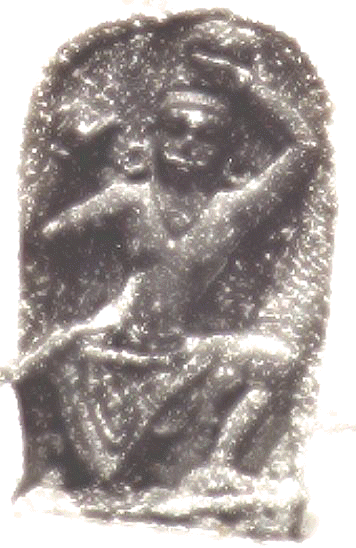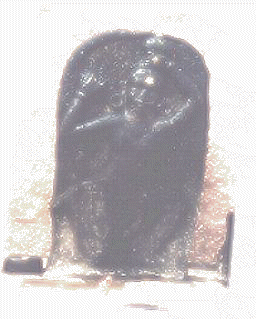 This is picture of a Virakkal dedicated to a warrior who performed self-sacrifice. He is wearing a scabbard in his waist. He is also wearing the "Vattudai" a garment worn by warriors. He grabs his hair with his left-hand and smites his neck with a sword which is held with his right hand. This statue is found in the Puumaayi Amman Temple of Tiruppathur, Sivagangai District, Tamil Nadu, South India.
This is picture of a Virakkal dedicated to a warrior who performed self-sacrifice. He is wearing a scabbard in his waist. He is also wearing the "Vattudai" a garment worn by warriors. He grabs his hair with his left-hand and smites his neck with a sword which is held with his right hand. This statue is found in the Puumaayi Amman Temple of Tiruppathur, Sivagangai District, Tamil Nadu, South India.
Description:
Self-sacrifice or Navakantam was an ancient practice among the Tamils in which a person sacrifices his own self with his own hands. It is a form of ritualistic suicide. Though outwardly resembling the Japanese Hara-Kiri, it differs in several ways from it. In Hara-Kiri, sometimes, the best friend cuts the head off, while the Samurai warrior slices his abdomen with his dagger. But the Tamils did it absolutely unassisted.
This custom was prevalent among the ancient Tamil warriors.
It was usually carried out as a fulfilment of a vow. There were various reasons for this.
Some examples:
 Scenario 1: A war with a mighty enemy against tremendous odds. There is no chance of winning. Divine intervention is besought. The warrior or warriors make a vow to offer their heads to Durga - the Goddess of War and Victory.
Scenario 1: A war with a mighty enemy against tremendous odds. There is no chance of winning. Divine intervention is besought. The warrior or warriors make a vow to offer their heads to Durga - the Goddess of War and Victory.
Victory is attained. The warriors offer their heads to Durga.
Scenario 2: The ancient Tamil kings had personal body-guards. They were the "VeLaikkaarap padai" of the Cholas and the "Thennavan AabaththudhavigaL" of the Pandyas. The latter were more fiercesome. Marco Polo who met them calls them, the " King's Trusty Lieges". The Pandya king is very ill. One of the body-guards makes a vow for his king's recovery. He offers his own life in place of the king's. The king recovers. So he gives his life as offering.
Scenario 3: A person suffering from terminal illness or untreatable disease. He decides to end his life. He chooses to sacrifice himself and attain Vira-Sorgam.
Scenario 4: A criminal is condemned. The king, however, gives him a choice. The criminal chooses to perform the rirualistic self-sacrifice. Thus his sins and crimes are washed away. He attains Paradise.
Scenario 5: A person is about to die of grievous wound or disease . But he has certain unfinished duties to carry out . He asks a particular deity for a postponement of death . He lives and finishes his task. After that, he voluntarily lays down his life to the deity as he promised.
Scenario 6: A man undergoes a great insult. He does not wish to live. But he does not wish to die a cowards death. So he performs the ritualistic suicide.
The Ritual:
When a person wishes to perform this ritualistic suicide, he calls all his friends and relatives for a very grand celebration. A festival is held in honour of the occassion. He is attired befittingly. There were certain rites which were performed at his house. It was funerary in nature. He takes leave of every-one. Then everybody goes in procession to the temple of the deity for whom the ritual is to be performed.
In the temple of the deity, the necessary rites are performed.
The self-sacrificer attains the proper posture on the ground.
A rhythmic beating of drums are accompanied by other musical instruments. While the priest is chanting the appropriate Mantras, the self-sacrificer grabs his hair and holds up his head with his left hand and holds a sword with his right hand.
Then, with a swift stroke, he smites his head off.
There was another variety called NavaKantam. In this the sacrificer cuts off eight parts from his body. The ninth and last part to be cut off, is the head. Hence, the name, "NavaKantam". In this ritual, the sacrificer has to do it unassisted. Since it is an elaborate rirual, it is time-consuming. So the whole process takes place slowly. The Zamorins-Saamudhiri Kings- of Calicut used to perform this.
Viirakkal:
The warriors are usually honoured with a Hero-stone called "Viirak Kal".
References
Literary References:
This custom is mentioned in ancient Tamil literature like the Maduraik Kaanchi, Chilappadhikkaaram, alingaththup ParaNi, etc. In the Chilappadhikkaaram, the warriors who won a victory for their king Karikaala Cholzhan are seen to scarifice themselves to the Chadhukka Bhutham of Kaviri Pumpattinam. The Bhutham was one of the guardians of the city. In another place, it perform for Durga. In the Kalingaththup ParaNi, we it being performed for Kotrravai who is KaLi.
Foreign References:
Marco Polo who visited the Pandya country in the 13the century A.D., was an eye-witness to such an event. Friar Jordanus , Nicolas de Conti, and others have mentioned about it in their travellogues.
Statues:
The above statue is in the Puumaayi Amman Temple in Tiruppathur, Sivagangai District, Tamil Nadu of South India. The temple is situated at the south-western part of the town. As such it was at the outskirt of the giant fortress that was there. It is actually a temple dedicated to Sapta Matrikas-The Seven Mothers. Puumaayi Amman is Vaishnavi or Vishnu Sakthi. She is in the centre of the row of the seven Matrikas.
Such statues are also found in Mamallapuram(MahaBali Puram), Thiruvaanaikkaa, and some other places. I found one such broken statue in a temple of Vadakku Vaasal Chelvi Amman in Kalappur, near Singampunari-same region as Tiruppathur. It is in the northern boundary of the "Lost City of Aruviyur".